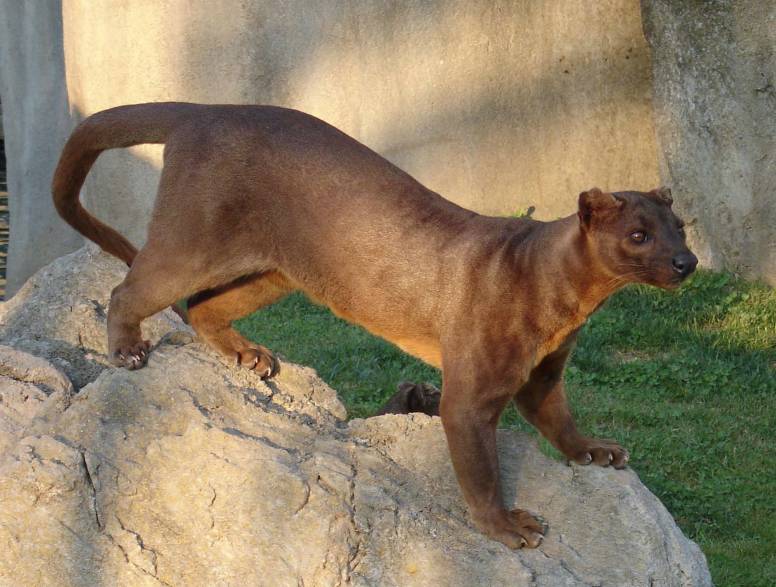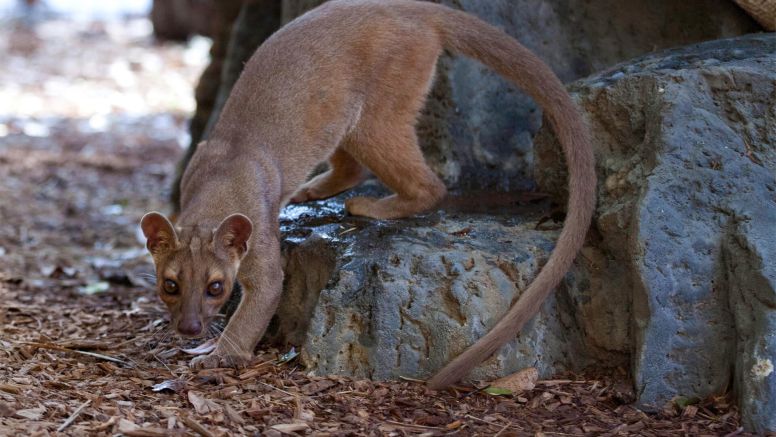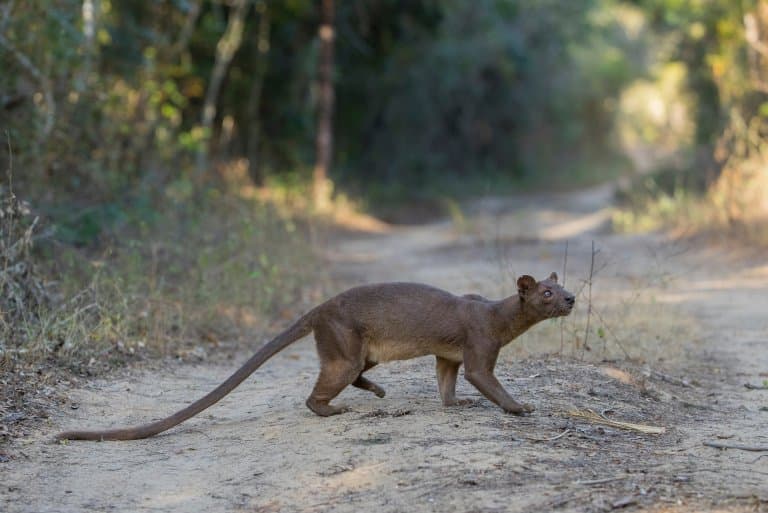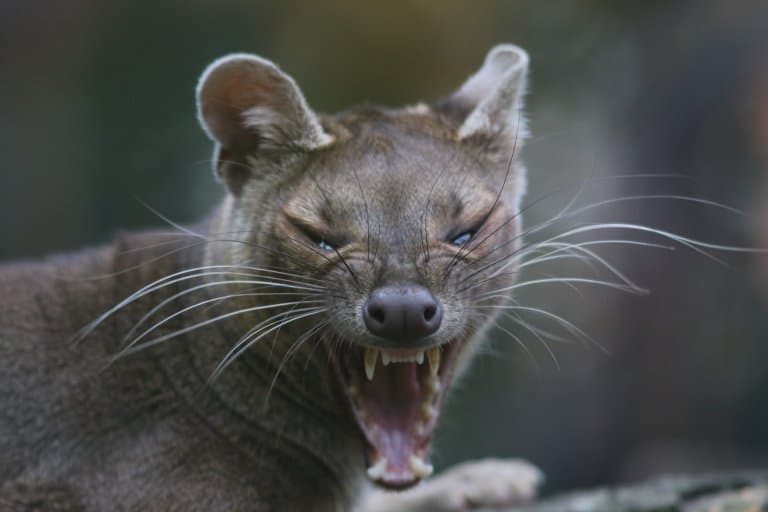Fossa Profile
The Fossa (pronounced ‘foosa’ or ‘foosh’) is a rare and elusive cat-like carnivorous mammal native to the island of Madagascar, off the East coast of Africa.
It belongs to a family of carnivorans that are closely related to the mongoose family. Due to the physical traits of the Fossa, the classification of this animal has been controversial.
Not only does it resemble a cat, there are other characteristics that suggest a close relationship with viverrids, which include civets and binturong.

Fossa Facts Overview
| Habitat: | Tropical forests |
| Location: | Madagascar |
| Lifespan: | 20 Years |
| Size: | 70–80 cm (28–31 in) |
| Weight: | 5.5 – 8.6 kg (12 – 19 lb) |
| Color: | Golden brown |
| Diet: | Carnivore – Lemurs, rodents, reptiles, birds |
| Predators: | Humans |
| Top Speed: | (55 kph) 35 mph |
| No. of Species: |
1 |
| Conservation Status: |
Vulnerable |
Fossas are medium sized, slender creatures with both feline and canine features: having a sleek body; short, strong legs; large catlike paws with sharp claws; round ears and a canine-like snout; and a very long tail.
They are both terrestrial and arboreal and inhabit widespread forested areas all over Madagascar, where they hunt their prey both high in the trees and down on the ground.
Although they can be found in many parts of the country of Madagascar – from mountainous woodland areas down to the lowland, coastal forests – they mainly inhabit remote and isolated areas and are rarely seen.
Fossas are active both at night and during the day, but are generally more active at night. They are carnivorous mammals, and feed mainly on lemurs – another Madagascan native – along with birds, reptiles and other small mammals.
Fossas are ambush hunters, meaning that they stalk or chase their prey, use their forelimbs and claws to catch it and then their sharp teeth to quickly kill it.
Their bodies are covered in a close, dense fur that is usually a reddish or golden brown in color, often with a paler underside. It’s possible for them to grow up to 6 feet in length from nose to tail-tip and, with their weight of up to 26 pounds for a fully-grown adult, fossas are the largest carnivore in Madagascar.
They are solitary creatures except during breeding and when the females are raising their young. Fossa are seasonal breeders and reproduce annually, between September and December.
Mating occurs high in the treetops. The female fossa selects a specific branch where mating will take place; this certain tree may well continue to be used for several subsequent mating rituals by other females during the same season. Once the female has chosen the site, several males will then compete for mating rights. They howl and roar to compete and intimidate, while the female makes mewing sounds to attract her mate.
The gestation period is around 60 days and the litter size is usually between two and four young, although it can be up to six in size. When it comes time to give birth, the female fossa will dig an underground den where the white-haired, blind and toothless pups will stay for at least the first four months. The pups will continue to stay with the mother until they are around 2 years old before finding their own way in the wild. Young fossas reach sexual maturity at about four years of age.
Fossas are becoming endangered because they are losing their habitat – their native home in the forests of Madagascar has been damaged to the point that only 10 percent remains in its original intact state.
They are elusive creatures and not much is known about them scientifically. They were formerly placed in the civet cat family Viverridae, before becoming reclassified into their own family of Eupleridae – a group of native Malagasy carnivores.
Interesting Fossa Facts
1. The fossa is the top predator in Madagascar
Being the largest carnivore on the Pacific island nation of Madagascar, the fossa enjoys the status of top predator native to the country.
They are known to feed on almost any creatures they can catch, from mice to wild boar. Most commonly, the fossa will prey upon the more than 30 species of lemur – another creature native and unique to wildlife-rich Madagascar. 1
2. The fossa’s long tail is used for balance while hunting in tree branches
The tail of a fossa can be almost as long as its body and is often used like a tightrope-walker’s balance pole – enabling the animal to quickly and agilely balance, jump and roam the treetops whilst hunting. They move so quickly that it is very difficult to catch a glimpse of these elusive beasts.

3. The scientific name comes from Greek origin and refers to their anus
Cryptoprocta is derived from two Greek words: krypto, meaning ‘to hide/conceal’ and proktos which means anus. This name refers to the fossa’s small anal pouch which obscures their anal cavity.
The Latin word ferox, however, means ‘brave’ or ‘fierce’, and refers to the animal’s ferocious nature. 2
4. The fossa is a relative of the mongoose
However, the slender and catlike body of the fossa bears little resemblance to its mongoose cousins with their more rodent-like features and chunkier, low-slung bodies.
Fossas are also relatives of the civet cat and the meerkat.

5. The fossa is considered ‘fady’ – taboo – in Madagascar
Although some evidence has been reported of Madagascans hunting and eating the fossa, it is generally considered a taboo animal and off limits for hunting.
This may be because the fossa is regarded to scavenge on the remains of dead ancestors buried in the forests. However, farmers have been known to kill fossas if they threaten or harm livestock or fowls.
6. Fossas communicate with one another mainly through their scent
Using the scent glands on their chests and below the base of their tails, fossas mark their surroundings to communicate with each other and keep track of one another.
These glands also release strong scents when the fossa is angry or scared.
7. Fossas have catlike features such retractable claws and sharp teeth
In another disparity to its relative the mongoose, the fossa has the feline qualities of retractable claws. These give the fossa the ability to walk silently, and creep up on their prey.
Their claws and flexible ankles also allow them to run up and down trees hunting rodents, birds and reptiles. Fossas also have very sharp, catlike teeth which they use to quickly kill their prey.

8. There are many local myths and legends about the fossa
These fierce and cunning creatures have inspired plenty of legends in their Madagasy home. Myths about the fossa include that they can kill poultry just with their scent, that they sneak into homes and kill babies in their beds, and that they can shrink the pupils of their eyes until they vanish.
It is even believed in some parts that a single lick from the fossa can put a person into a deep sleep or trance from which they are unable to be woken, whereupon the animal devours their intestines and leaves them for dead!
Needless to say, none of these scary stories have any concrete evidence to back them up.
9. Fossas can travel up to 26km in a day
Although they spend a lot of time in the trees, fossas are also comfortable running along the ground and can cover large distances while hunting.
10. The fossa is the only predator able to catch the largest of the lemur species
Despite the lemur’s speed and agility, the skillful fossa can outmaneuver the quickest lemur and is their biggest predator.
11. Fossas go down trees headfirst, like squirrels
Due to their retractable claws, flexible ankles and long tail helping them to balance, fossas are remarkably agile and are able to run up and down trees with ease, leaping from branch to branch in search of their prey.

12. Fossas are threatened by habitat loss
Contained on the island of Madagascar for millennia, the fossa became the biggest carnivore on the island and had no natural predators – therefore dominating the forests they call home.
However, deforestation and habitat degradation threaten their very existence, as their main source of prey – the lemur – depend upon the forest for survival.
Fragmentation is also a problem for the fossa, because the reserve areas in which they live are often not large enough to support a healthy population.
In addition, there has been the introduction of some non-native species, such as the civet cat, which compete with the fossa for food, as well as diseases such as rabies creeping in from domesticated animals like dogs and cats.
This combination of factors means that the fossa is currently classified as vulnerable and there are only around 2500 remaining in the wild. 3 4
Fossa Fact-File Summary
Scientific Classification
| Kingdom: | Animalia |
| Phylum: | Chordata |
| Class: | Mammalia |
| Order: | Carnivora |
| Suborder: | Feliformia |
| Family: | Eupleridae |
| Genus: | Cryptoprocta |
| Species Name: |
Cryptoprocta Ferox |
Fact Sources & References
- “Fossa“, National Geographic.
- “Fossa (Cryptoprocta ferox) Fact Sheet: Taxonomy & History“, San Diego Zoo Wildlife Aliiance Library.
- “Fossa (Cryptoprocta ferox)“, Aspinall Foundation.
- Jeremy Hance (2011), “Saving Madagascar’s largest carnivorous mammal: the fossa“, Mongabay.
